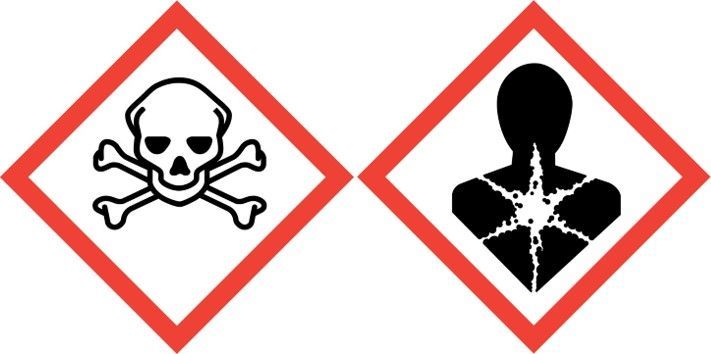When working with chemicals it is important that you know the precautions related to labelling, classification, H-statements, CMR-substances, risk assessments, waste management and chemical inventory, as well as have the necessary training.
Labelling of chemicals
It is EU's CLP regulation that is in used when labelling chemicals. The legislation ensures that the hazards presented by chemicals are clearly communicated to workers and consumers. Chemicals are labelled with hazard pictograms and H-statements that describe the chemical's intrinsic properties.
EU's REACH regulation aims to improve the protection of human health and the environment from the risks that can be posed by chemicals.
Working with GHS06 and GHS08

All work with chemicals labelled GHS06 og GHS08, should be performed in a fume hood. No one should be exposed to these chemicals. Accidents/spills must be reported via Speak up!
Health hazard linked to these chemicals:
- May cause cancer (Carcinogenic), genetic effects (Mutagenic) and/or toxic for Reproduction: H340, H350, H360, H360FD, H360Fd, H360Df)
- Suspected of causing cancer (carcinogenic), genetic effects(mutagenic) and/or toxic for reproduction: H341, H351, H361, H361f, H361d, H361fd)
- May cause allergy or asthma symptoms or breathing difficulties if inhaled (H334)
- Toxic/Deadly if inhaled. (H330, H331)
- Toxic/Deadly if swallowed/skin contact. (H310/H311, H300/H331)
- Target organ toxicity – Single Exposure, Specific target organ toxicity (H370), Repeated Exposure (H371) or chemicals that caused irritation or nausea (H335, H336)
ECOonline
All Norwegian companies and businesses are obliged to keep a chemical inventory, a complete overview of all chemicals stored and in use. At UiO we use an online chemical inventory called ECOonline.
Risk assessment
All work including chemicals should be risk assessed in the form of an SOP.
Mandatory training when working with chemicals
Take the web course today!
Laboratory waste
All risk waste (including small amount of chemicals) should be disposed in the yellow containers. UiO is practicing a zero waste to drain policy. In other words, NO chemicals or solutions should be poured in the sink. Follow the instructions in the datasheet and SOP.
Disposal of chemicals
All hazardous waste should be disposed. UiO is practicing a zero waste to drain policy. Follow the instructions in the datasheet.
Substituting hazardous chemicals
Substitution means replacing. We have to assess how we use chemicals and, when possible, substitute hazardous chemicals with less hazardous ones.
An example can be to buy ready made solutions on stead of preparing them ourselves.
Pregnant in the lab
If you get pregnant, please contact your supervisor, lan manager, hms-team, safety representative, and/or BHT for guidance to lab work during pregnancy.
